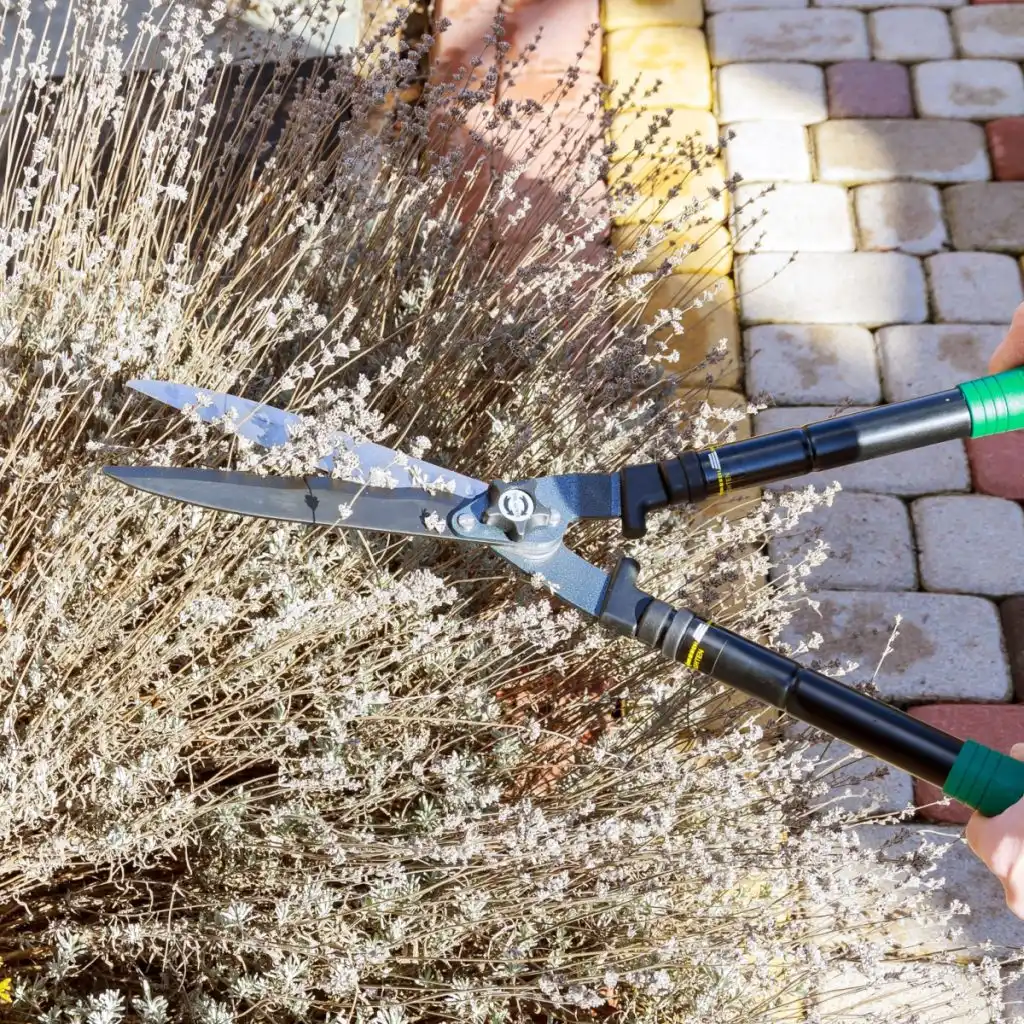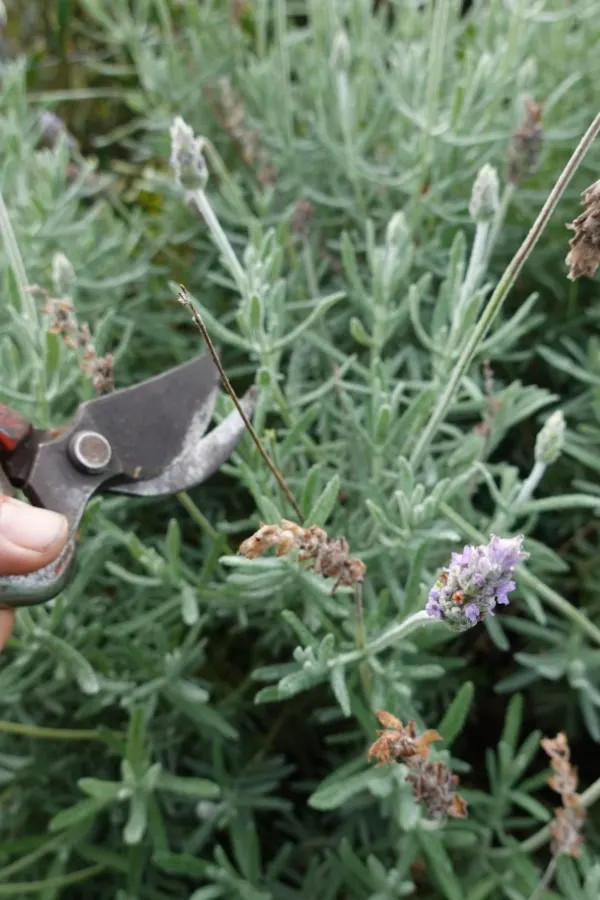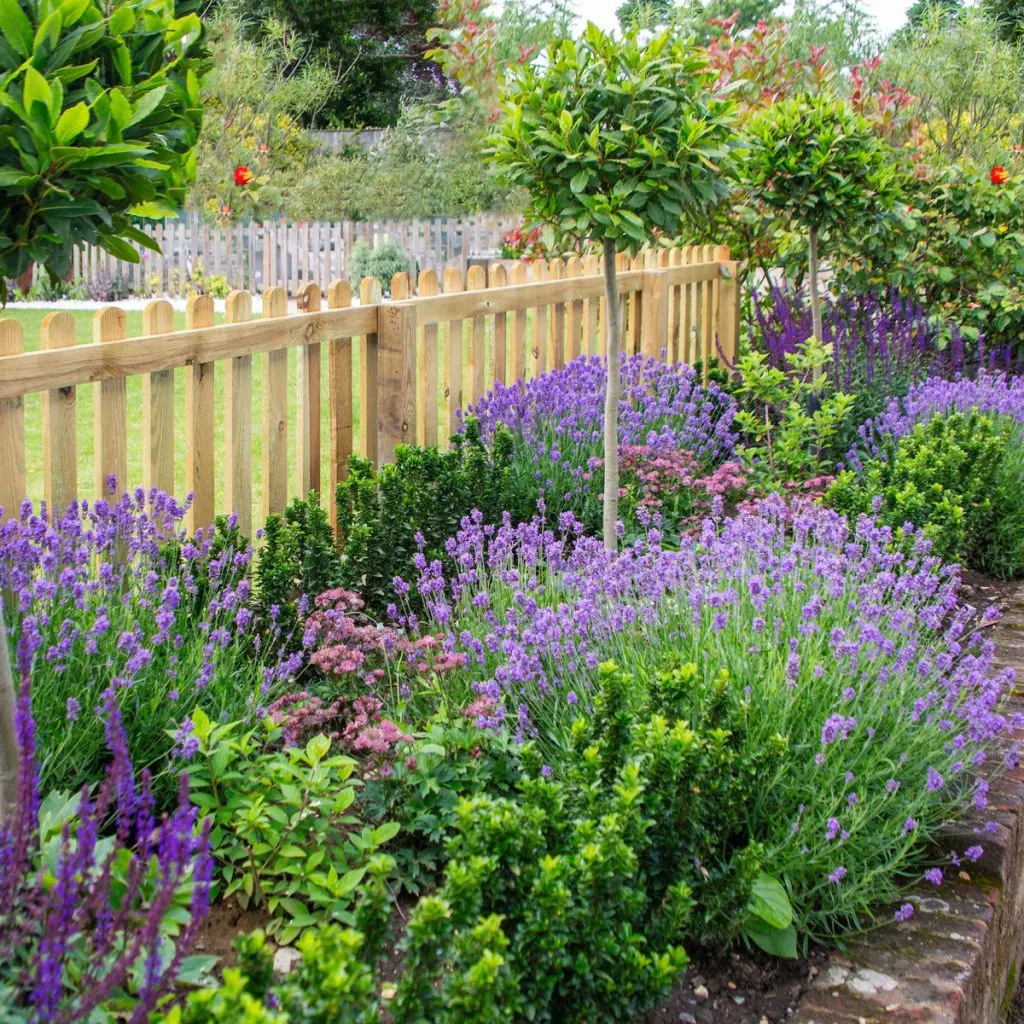Wondering what to do with your lavender plants this spring – and wondering if you need to prune them back or fertilize them for bigger and better flowers this year?
When it comes to lavender, many gardeners are often confused by what to do. Should you prune it? And if so, when’s the best time to cut it back – before new growth starts or after? And how much should you cut?
The truth is, spring is the ideal time to prune lavender, and doing it right can lead to stronger, healthier plants filled with flowers. Spring pruning not only keeps lavender looking good, it also helps the plant grow thicker, stay more compact, and produce far more blooms.

What To Do With Lavender In The Spring – Why Spring Pruning Matters
Lavender comes out of its winter sleep slowly. You’ll start to see small green shoots forming low on the plant as temperatures rise. And this is the best time to jump into action to prune. Trimming the plant right when it starts growing again helps direct its energy into the new shoots, which leads to more flowers later on.
If you prune too early – as in late winter or very early spring – you might damage the plant if a cold snap hits. Lavender is sensitive to late freezes, especially after it’s been trimmed. On the flip side, if you wait too long and prune in summer or fall, you could accidentally cut off developing buds.
Late pruning also puts the plant at risk of winter damage if it doesn’t have enough time to harden off again. By pruning in early to mid-spring, when you first spot green growth, you avoid all of these problems and set your plant up for success.
Avoid Pruning First-Year Lavender
One big rule when it comes to pruning lavender is to skip the trim during its first growing season. Young lavender plants need time to get their roots established. Pruning them too soon can stunt their development.

Instead, focus on letting the plant grow naturally during its first year. The only trimming you should do is to pinch off the tips of any flowers to encourage branching. Once your lavender has made it through a full season and comes back the next year, it’s ready for a full spring prune.
From that point on, annual spring pruning is key. Skipping a yearly trim can cause the plant to get woody and uneven, which reduces flower production and makes the plant harder to shape. Older, unpruned plants often grow tall and split open in the middle, especially after a rain or windstorm.
How Lavender Blooms – And Why It’s Important
Lavender flowers only grow on new stems. This is why pruning each spring is so important. When you trim the plant, it encourages it to send up lots of new shoots. These are the stems that will hold your blooms.
The more new stems you get, the more flowers your lavender will produce. Pruning also keeps the plant from getting too tall and leggy. With regular trimming, lavender stays more compact, full, and manageable.
Wait until you see new growth forming at the base of the plant. This usually appears as tiny green leaves starting to sprout on the lower parts of the stems. That’s your signal that it’s safe to prune.

Use clean, sharp garden shears or scissors to cut back the plant. Start by removing the dead-looking, grayish parts of the stems. You’ll want to cut just above where the new green growth is starting.
Avoid cutting down into the brown, woody parts of the stem that don’t have green shoots. Lavender doesn’t regrow well from these older, hardened areas. A good rule of thumb is to trim back about one-third of the plant. That might mean taking a few inches off, or more, depending on how large or leggy your lavender has become.
For thick, healthy plants, you can trim a bit more. If your plant seems stressed or weak, it’s okay to prune a little more lightly. As you prune, try to shape the plant into a gentle, rounded mound. This shape helps it grow evenly and avoids issues like splitting down the center as it matures.
Last but not least, always try to make sure you leave a bit of green on each stem so it can bounce back quickly.
Fertilizing & Other Spring Lavender Tips
Pruning isn’t the only task to focus on in spring. While you’re tending to your lavender, there are a few other simple things you can do to give your plants a boost.
Start by checking the soil. Lavender grows best in soil that drains quickly. It struggles in heavy, clay-like soil that stays wet too long. If your lavender didn’t do well last year, soggy roots might be the reason.

You can help by adding sand, gravel, or other materials to improve drainage. If needed, consider raising the plant or even replanting it in a better spot. Also, spring is the perfect time to give your lavender a gentle feeding. But be careful not to overdo it.
Too much fertilizer can cause the plant to produce lots of leaves but fewer flowers. Use a light fertilizer designed for lavender, or a few inches of compost around the base of the plant. This will slowly feed the roots as rain and watering carry the nutrients down into the soil. Affiliate Link: Premium Liquid Lavender Plant Fertilizer – 3-1-2
Mulching Around Lavender
Adding mulch can also help, especially as the weather warms up. A few inches of light mulch will help keep weeds down, hold in moisture, and regulate soil temperature. Just be sure not to let the mulch touch the base of the plant. Lavender stems can rot if they stay too wet, so it’s best to leave a little space around them.
You can use straw, shredded bark, or other light mulch materials. Avoid anything that holds too much water, and don’t pile it up too high. A light layer is all it takes.
Mid Summer Pruning
While the main pruning happens in spring, you can also do a light trim in mid-summer, right after the first bloom cycle is finished. This can sometimes encourage the plant to bloom again later in the season. Just be gentle – don’t cut too deeply, and always leave plenty of green growth so the plant can recover quickly.
But even if you skip the second pruning, your spring trim is what really makes the difference. Regular pruning every spring helps keep lavender full, blooming, and beautiful – year after year. Last but not least, make sure you deadhead your lavender in the fall before winter arrives. See our article: What To Do With Lavender In The Fall.
Spring pruning might feel like a big step at first, especially if your plant looks like it’s just starting to grow. But once you see the results – thicker growth, more flowers, and better shape – you’ll see just how much good a simple spring trim can do for your lavender.
Simple Garden Life
Follow Our Facebook Page For Even More Great Tips! Simple Garden Life Facebook Page
Simple Garden Life is a website dedicated to keeping gardening fun, simple and enjoyable! We publish two new articles each week along with a new garden podcast episode every two weeks. This article may contain affiliate links.

